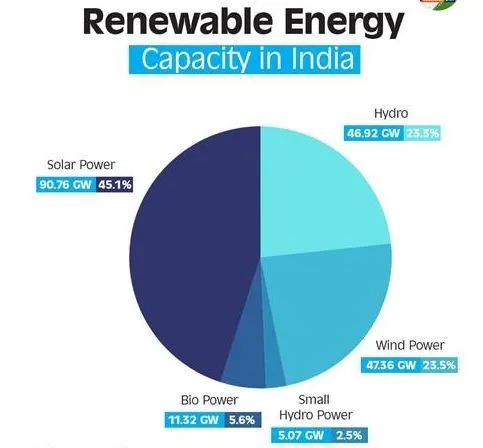Syllabus: GS3/Energy
Context
- The 3rd edition of the World Solar Report series was released at the 7th Assembly of the International Solar Alliance.
About
- The newly launched 4 reports namely World Solar Market Report, World Investment Report, World Technology Report, and Green Hydrogen Readiness Assessment for African Countries each highlight a crucial area in the global shift towards sustainable energy.
- First introduced in 2022, this series provides a comprehensive overview of global progress in solar technology, key challenges, and investment trends in the sector.
Key Highlights
- World Solar Market Report
- Rise in Solar Capacity: Global solar capacity has increased from 1.22 GW in 2000 to 1,418.97 GW in 2023—a 40% annual growth rate.
- Solar Industry Employment Boom: It provides 16.2 million jobs, with solar leading with 7.1 million—up 44%, and 86%.
- World Investment Report
- Exponential Growth in Energy Investments: Global energy investments are set to soar from $2.4 trillion in 2018 to $3.1 trillion in 2024—a steady climb at nearly 5% annually.
- APAC leads global solar investments: APAC is at the forefront of solar investments pouring USD 223 billion into solar in 2023.
- World Technology Report
- It include record-setting 24.9% efficiency in solar PV modules, an 88% reduction in silicon usage since 2004, and a 90% drop in utility-scale solar PV costs, fostering resilient, cost-effective energy solutions.
- Readiness Assessment of Green Hydrogen in African Countries’report
- Green hydrogen offers a viable alternative to coal, oil, and gas, supporting Africa’s transition to cleaner energy.
About the International Solar Alliance
- It is an international organisation with 120 Member and Signatory countries.
- Established: By Prime Minister Narendra Modi and President of France Francois Hollande in 2015.
- Headquarter: First international intergovernmental organisation to be headquartered in India.
- Mission: To unlock US$1 trillion of investments in solar by 2030.
- Reducing the cost of the technology and its financing.
India’s Renewable Energy Capacity
- India’s total electricity generation capacity has reached 452.69 GW.
- Having the 8,180 MW (megawatt) of nuclear capacity, the total non-fossil fuel-based power now accounts for almost half of the country’s installed electricity generation capacity.
- As of 2024, renewable energy-based electricity generation capacity stands at 201.45 GW, accounting for 46.3 percent of the country’s total installed capacity.
- Solar power contributes towards 90.76 GW, wind power follows closely with 47.36 GW, hydroelectric power generating 46.92 GW and small hydro power adding 5.07 GW, and biopower, including biomass and biogas energy, adds another 11.32 GW.

India’s Targets
- India has a vision to achieve Net Zero Emissions by 2070, in addition to attaining the short-term targets which include:
- Increasing renewables capacity to 500 GW by 2030,
- Meeting 50% of energy requirements from renewables,
- Reducing cumulative emissions by one billion tonnes by 2030, and
- Reducing emissions intensity of India’s gross domestic product (GDP) by 45% by 2030 from 2005 levels.
Source: PIB
Previous article
Rising STEM Research Demands Revitalised Education
Next article
News In Short 06-11-2024